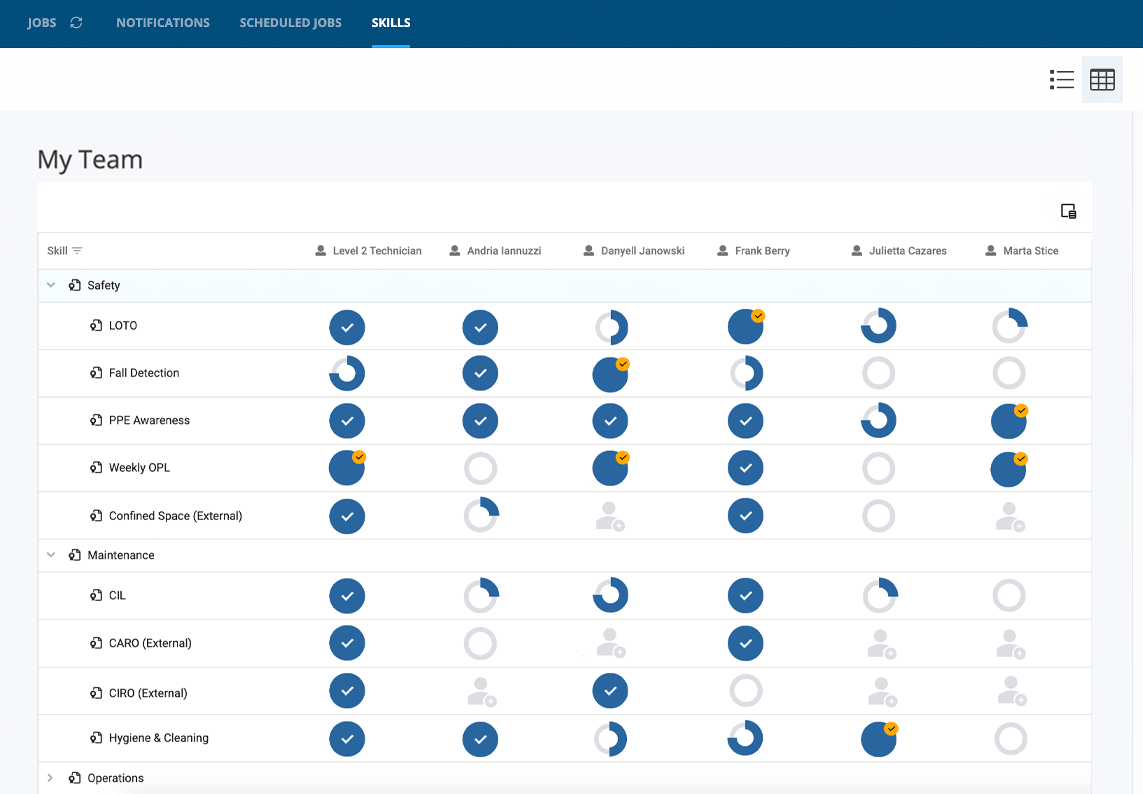Learn about what a skills matrix is, how these can be used and alternatives to help track employee skills.
A skills matrix is a grid that maps employees’ skills and qualifications. Companies use this information to manage, plan, and monitor current and desired skills for a position, team, department, or project.
Having a place to store each employee’s skills and experience level can help managers decide how to divvy up tasks. It’s also a great way to gauge areas of improvement.
A skills matrix is usually managed using a spreadsheet, but there are alternatives to skill matrices. For example, cloud-based skills management software can help identify and track employee competence and correlate it with actual job performance. The software can also help managers filter employee databases by skills to assemble teams or assign work based on specific qualifications.
To help you learn more about the skills matrix and its alternative, this article explores the following topics:
- What is a skills matrix?
- What are the benefits of using a matrix to track employee skills?
- How do I create a skills matrix?
- How can skills matrices be used in the manufacturing industry?
- What are the alternatives to using a spreadsheet for your skills and competency matrix?
What is a skills matrix?
A skills matrix is a tool used by employers to track workers’ skills and expertise. Typically maintained in spreadsheet format, it usually includes skills that workers already possess, ones that are needed but underdeveloped, and those that are required to complete a project or perform a job function.
Each employee is given a rating on their proficiency in each skill and their interest in developing it. This gives managers great insight into who is qualified to complete certain tasks.
What are the benefits of using a matrix to track employee skills?
A skills matrix offers multiple benefits that can increase team performance and boost productivity. Some of its benefits include:
1) Brings awareness to employee skills
This tool shows what area a team member excels at and where they can improve. This can bring awareness to what skills need to be cultivated and what areas team members are already proficient in.
2) Sets team expectations
With the matrix outlining what skills are needed to complete a project, employees have a better idea of what’s expected and required to be proficient in their roles.
3) Shows where new hires are needed
The matrix gives employers a better idea if someone needs to be hired to fulfill a certain role. Knowing which skills are missing helps managers determine what kind of employee needs to be hired for a specific project.
How do I create a skills matrix?
Creating a skill matrix can provide a wealth of benefits to a business. You can set one up by following the steps below:
- Determine which skills are needed for your team based on job function or responsibility.
- Evaluate your workers’ skills and qualifications.
- Create a grading system to rate each employee’s current skill level.
- Fill in the missing criteria and manage the information in a central skills management system.
How can skills matrices be used in the manufacturing industry?
The manufacturing industry is always seeking skilled employees. Skilled matrices are an excellent way to cultivate the skills of current production plant workers and boost productivity.
This organizational tool also simplifies the hiring process. For example, it gives managers a better sense of what skill areas are lacking and who may be the right fit for the role.
The better equipped an employee is to do their job, the better a company’s bottom line will be.
What are the alternatives to using a spreadsheet for your skills and competency matrix?
If you’re looking for an alternative to using a spreadsheet to manage the skills of your team, consider cloud-based skills management software. These programs help businesses identify and track worker competency.
For example, this software maps skills from a centralized library to job profiles and individual employees to help managers analyze the abilities of their teams, the desired skills for each role and any skill gaps that exist. Learn more about skills management software in our guide.
Furthermore, skills management software not only allows you to efficiently manage skills for your frontline workers, it also enables you to use this skills mapping to intelligently assign work or identify upskilling or reskilling needs.



